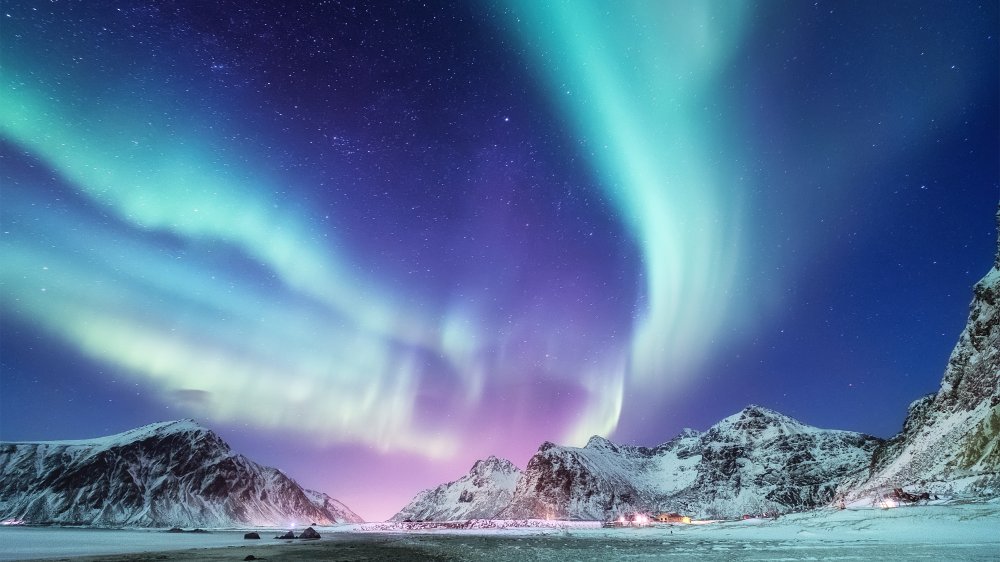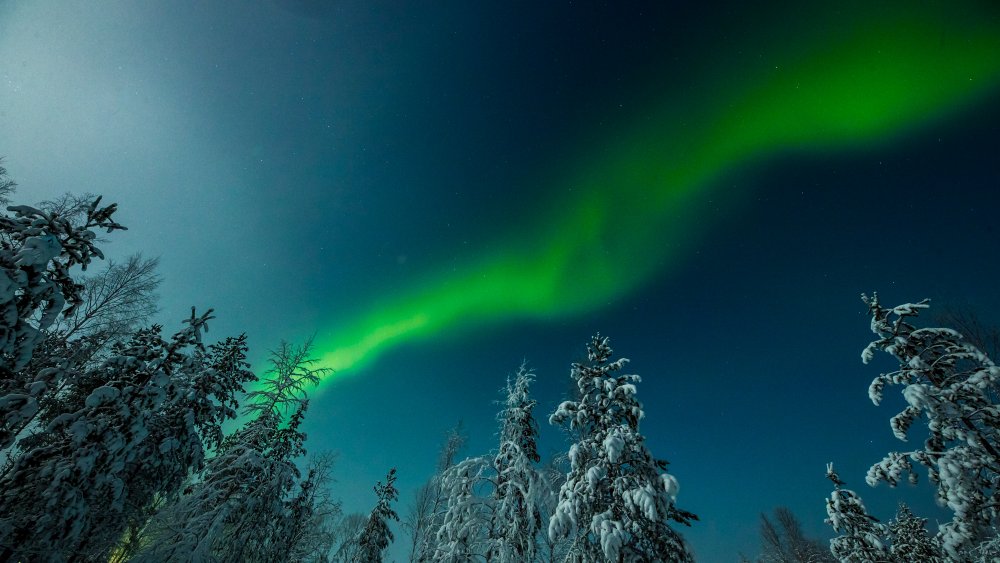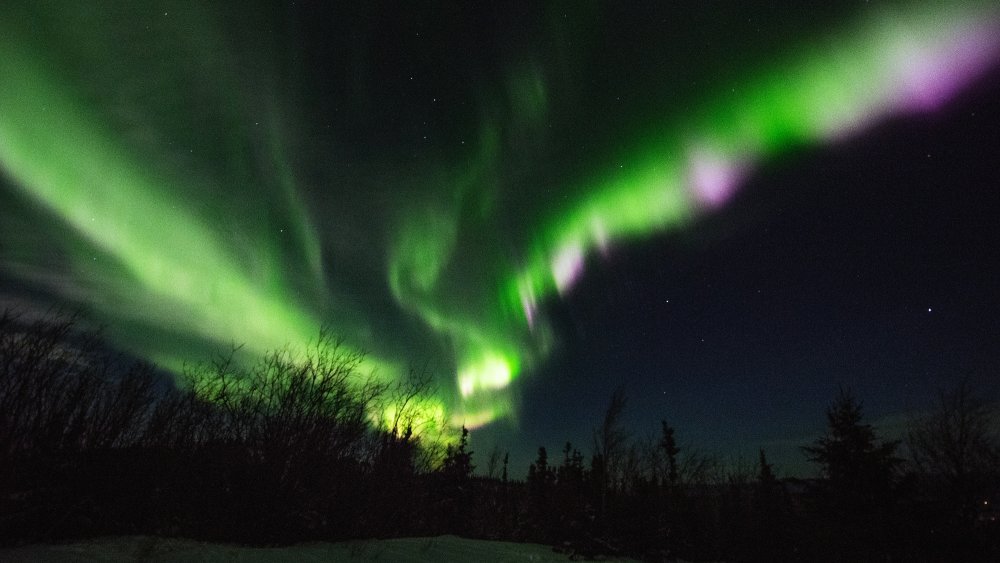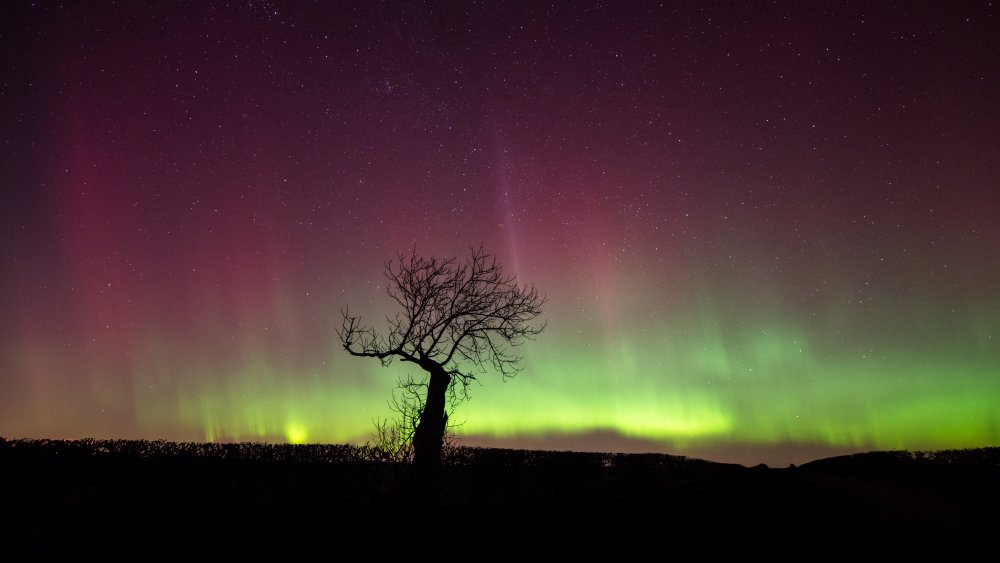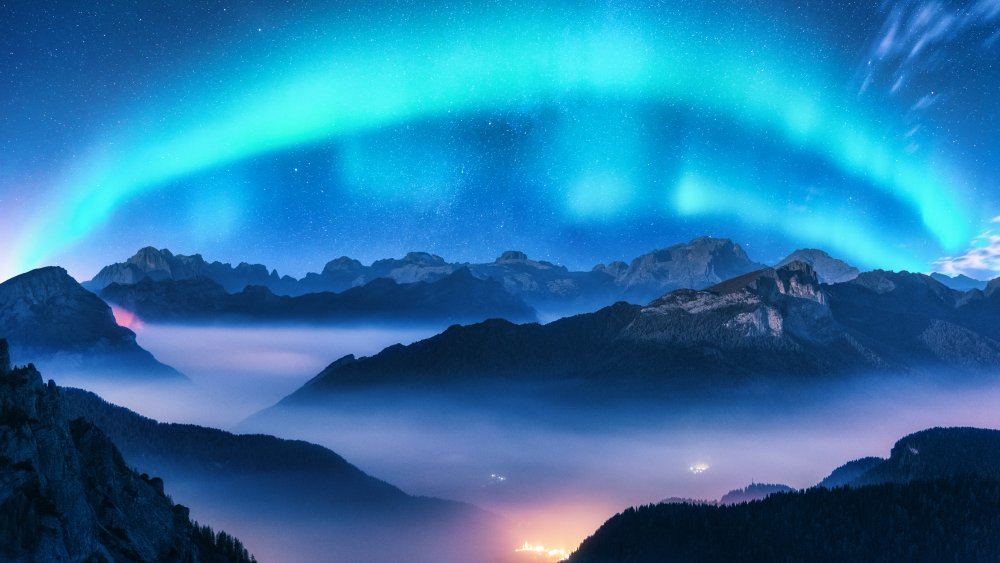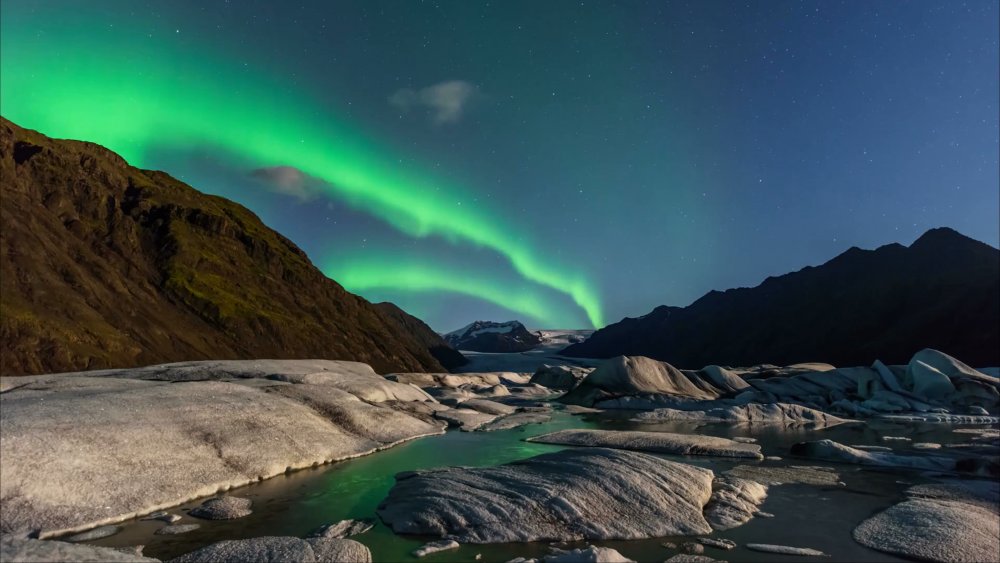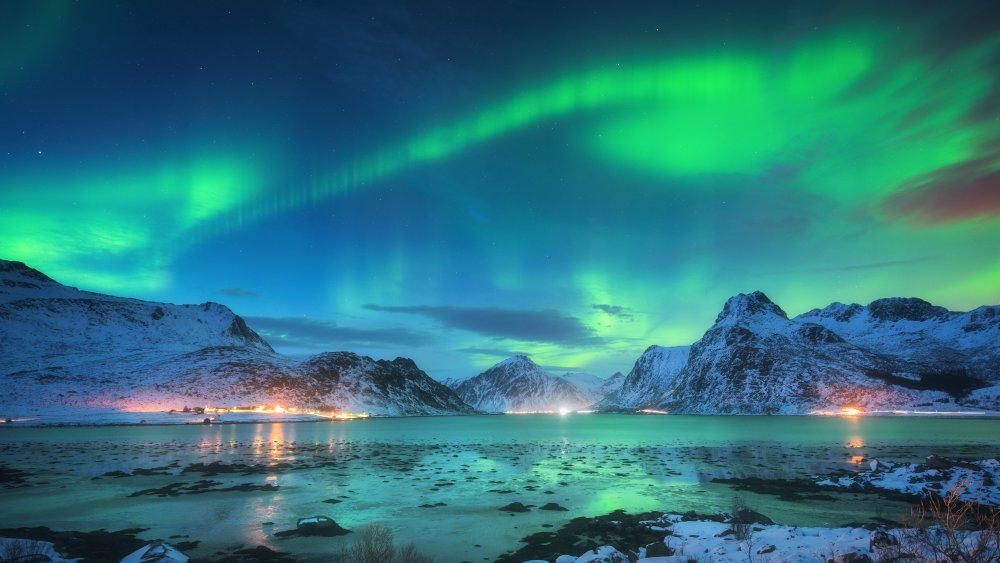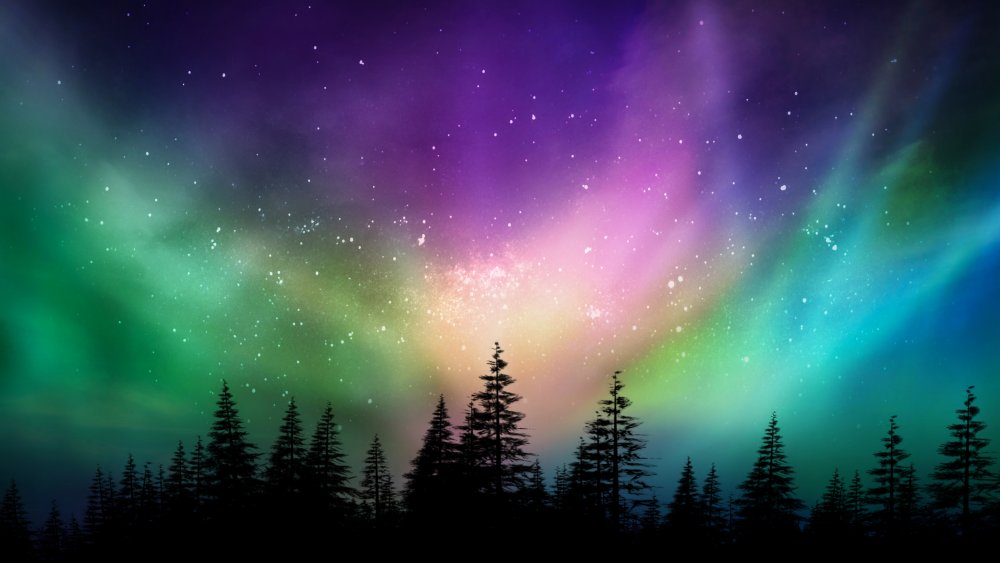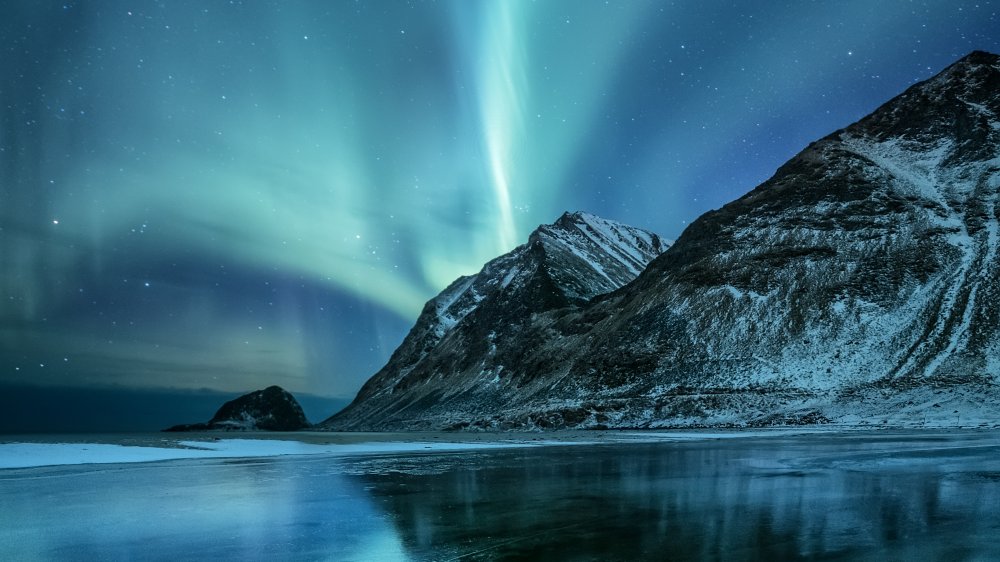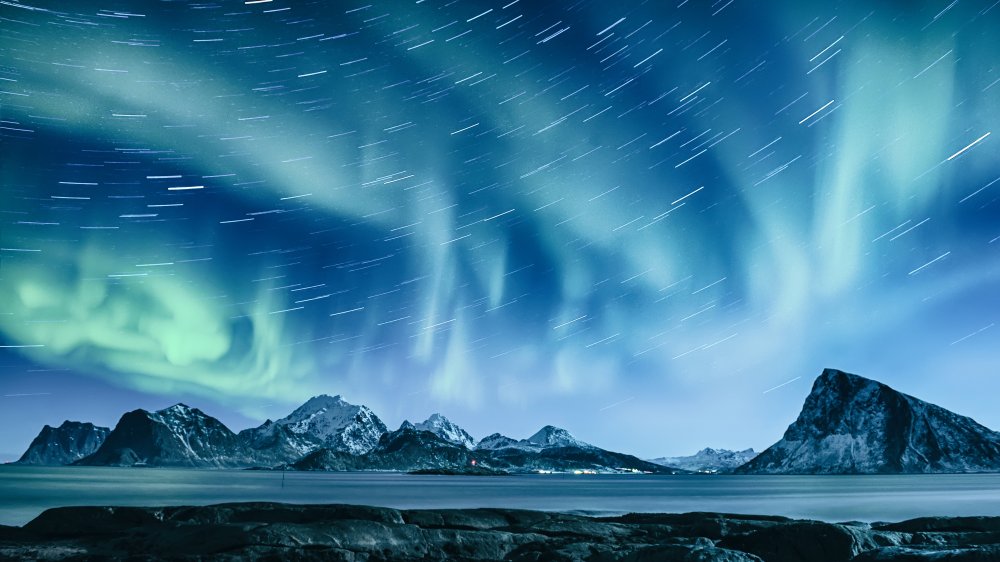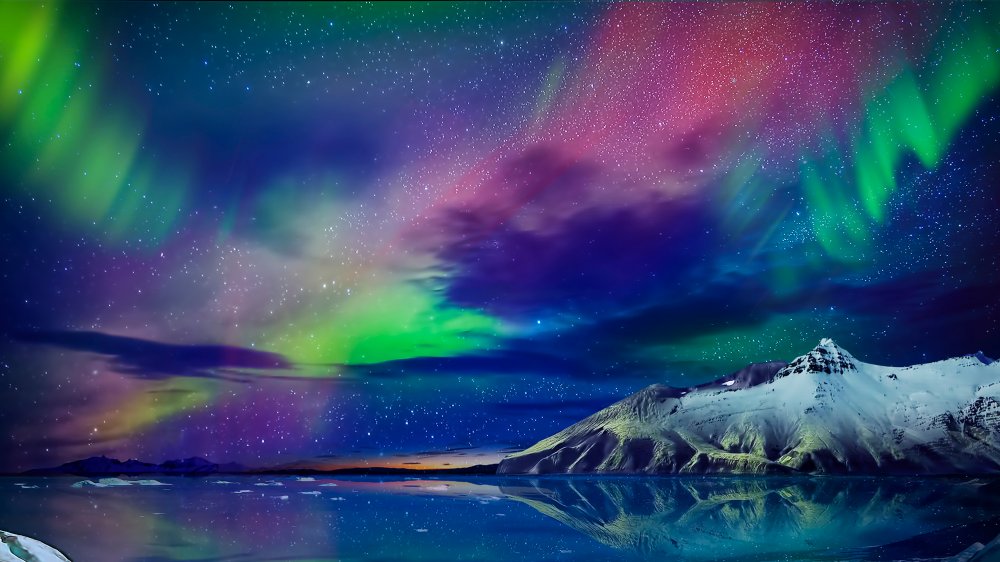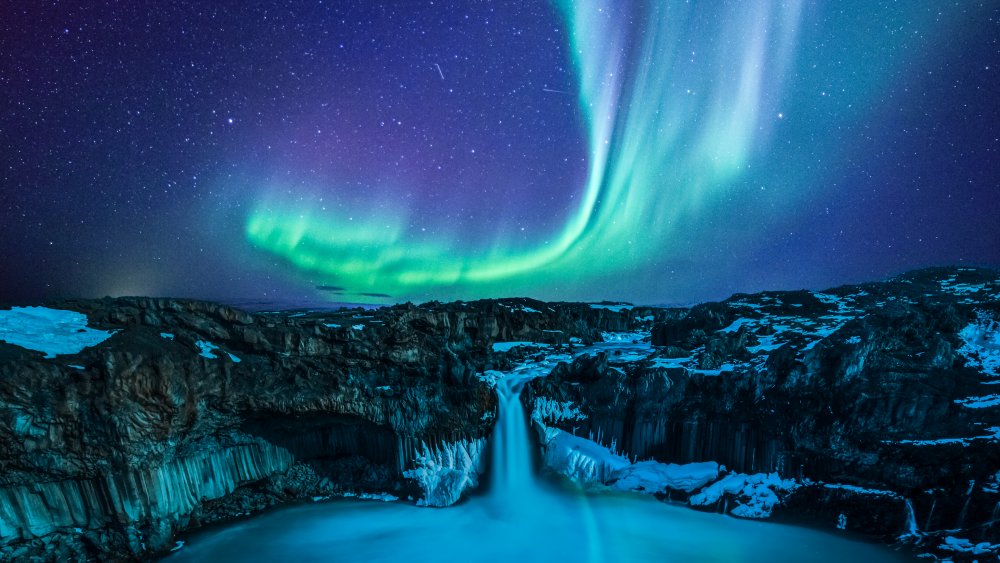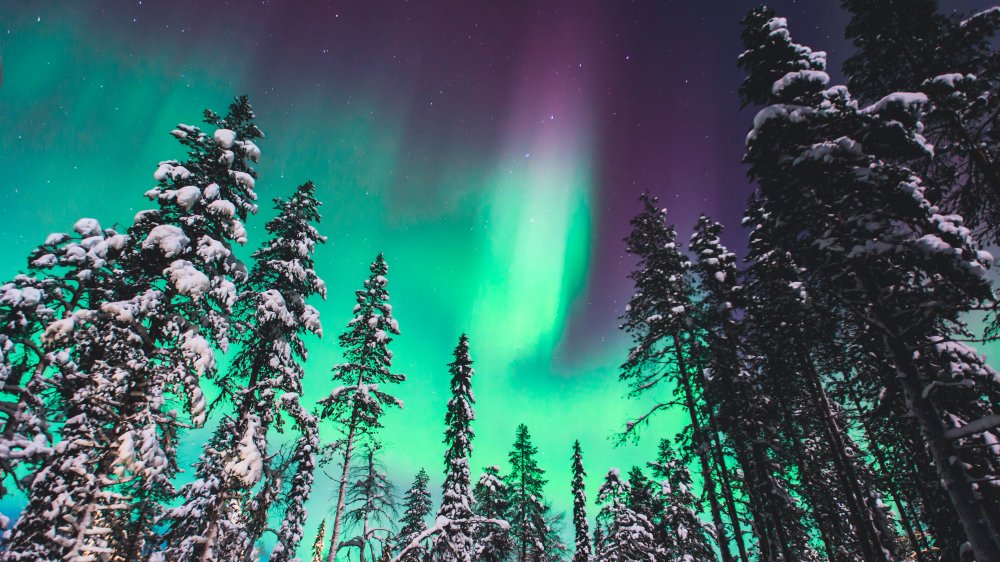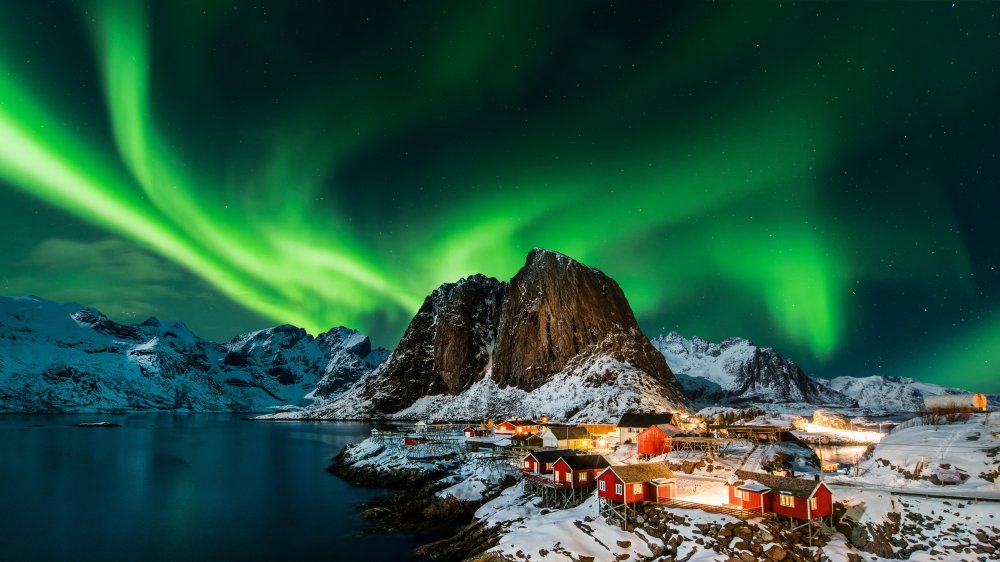The Mythology Of The Northern Lights Explained
While it's true that the world is a scary, sometimes awful place filled with all kinds of terrifying things, it's also a place where there's unimaginable beauty to be found. It's all around us: from rainbows, clouds, and pure white snow to coral reefs, blue whales, and raging volcanos. All we need to do is stop, take a deep breath, and look around.
Our ancestors definitely did, and when they took notice of the natural miracles they were surrounded by, they did something we've lost the art of. They made up stories to explain what they were seeing. Sure, we have science on our side now, but there's something to be said for a good story.
Take the Northern Lights. They're a spectacular display of color that dances across the night sky at certain times, kind of like Mother Nature's own Pink Floyd laser light show.
Now, we know the colors of the Northern Lights originate on the surface of the sun. Sun storms send particles flying off across space, and EarthSky says that when our planet gets in the way of those particles, they react with our atmosphere and magnetic field and cause the atoms above us to light up. Different gases turn different colors, and that's pretty cool. We didn't know that hundreds of years ago, though, so our ancestors made up their own stories about what they were seeing. And some of those were even cooler.
The Sami: spirits of the dead in the lights
The Sami are a group of people who live in Lapland and the neighboring countries of Finland, Sweden, and Norway. They've lived there for thousands of years, and according to Britannica, they're currently settled mostly in the northernmost reaches of Scandinavia — which gives them a front-row seat to the Northern Lights.
It's not surprising that when the University of Central Lancashire started compiling stories about the lights (via The Telegraph), the folklore of the Sami was among the tales. They say that according to Sami mythology, the lights are actually coming from the souls of the dead. The long-held belief is still repeated today, and along with that comes a reverence for the lights.
When there's a massive display of lights, the Sami will do their best to remain inside out of respect for the souls they believe to be in the sky above them, and they absolutely will not whistle. Anyone who commits the dual misstep of being outside under the lights and whistling runs the risk of attracting the attention of the dead, who might just come down to whisk them away into the sky.
The Sami also believe in a sacred bear who was said to have rescued at least one person that the spirits attempted to steal away, but this is one of those times that it might just be better to be safe than sorry.
The Menominee: benevolent giants create the Aurora Borealis
While the Tromso Geophysical Observatory says that the best place to see the Northern Lights is within about 1550 miles of the North Pole, it is possible — although less likely — that those living even farther south will catch a glimpse during a particularly fierce storm. Visit the USA says those in Idaho, Maine, Minnesota, and other states along the border between America and Canada can sometimes catch a glimpse of them, and that explains why the Menominee — a tribe of Native peoples living in Wisconsin and along Green Bay — have developed their own folklore about the lights.
According to Bivrost, Menominee legend says the lights are actually the glow from the torches carried by members of a race of giants called the Manabai'wok. These giants live in the north, and they've long been revered as a friendly sort who, legends suggest, used to interact with their southern friends. Even though they no longer do, they're still revered as great fishermen and hunters. Their torches are said to come out when they're fishing at night, and they are believed to guide other fishermen to the places where the schools have gathered and where fishing will be the most fruitful.
Scotland: The Nimble Men
The Northern Lights aren't as common a sight in Scotland as they are in, say, Norway or Finland, but Nordic Visitor says that it is still possible to see them on occasion. When they did appear, Scottish storytellers wove an incredible tale to explain what was going on, and it was recorded in the 1917 tome Wonder Tales from Scottish Myth and Legend.
The lights were the children of Beira, Queen of Winter. They were called the Merry Dancers or the Nimble Men, and her children were divided into several clans. The men of one clan were identified by their pure white clothes and the men of another wore only yellow, while the ladies of both clans dressed in a myriad of red, green, purple, and white.
When the Nimble Men and their Merry Maidens decide to dance, they light up the night sky with their colorful clothing and their graceful, elegant movements. But it hasn't all been peaceful: Legend says that when a prince of the White and a chief of the Yellow both fell in love with the most beautiful of the maidens, the clans went to war over her. Blood was shed and ran from the sky, splashing across the stones of Scotland's mountains, which are still speckled and called bloodstones today. And as for the maiden and her suitors? She searched the battlefield and found the prince of the White — who she had agreed to marry — among the dead.
The Inuit: spirits of children are in the Northern Lights
The Inuit, The Canadian Encyclopedia says, are defined as the indigenous people who live in the northernmost regions of Canada. Their homeland is called Nunangat, and refers to all parts — water, ice, and land — in the Arctic. Today, there are eight separate ethnic groups, and while different groups tell slightly different stories, the theme is very similar.
According to some tales, like the one told by the Hudson Bay Inuit, Bivrost points out— the lights are spirits entering the afterlife. There were different parts of the afterlife for those who died in different ways, and the highest was the Aurora. It was reserved for those who died violent deaths, so they could finally know peace. The spirits already there — along with the Raven — light torches to guide new spirits home.
In the 1920s, the Danish explorer Knud Rasmussen recorded another story, told by the people he met on the island of Iglooik. They believed that the Northern Lights were caused by spirits who were playing a game, sort of like a heavenly version of soccer, but with a walrus skull as a ball.
There are a few different variations on this idea: people from the island of Nunivak said those playing the game were walruses, and the ball was a human skull. Other groups told their children that the skull was plucked from the shoulders of a naughty, disobedient child, while others believed the spirits were the souls of children who had been still-born.
Danish swans and icy wings make the lights
Europe has a massive swan population, and according to the European Union, some are migratory and others stay in certain places, like Britain, all year round. Denmark is one of the countries that has a wintertime population of swans, which goes a long way in explaining their odd yet beautiful tale about the Northern Lights.
It's a bit of a cautionary tale with a happy ending. According to Danish folklore (via Hurtigruten), a group of swans decided to have a competition. The winner was the swan who flew the farthest north, but some of the swans flew so far into the cold and the snow that their wings began to freeze. Some became trapped in the ice and struggled to free themselves. When they finally escaped and took to the air again, the flapping of their wings shook ice crystals loose, reflecting the light and causing the colors of the Aurora Borealis.
The Cree: circle of life in the Northern Lights
The Cree are a Native American tribe who originally had a sprawling domain that reached from the Hudson River into Alberta, Canada. They suffered greatly during outbreaks of smallpox, Britannica says, and both groups — the Great Plains Cree and the Woodland Cree, called Swampy or Maskegon Cree — told incredible stories about the world around them.
According to the University of Central Lancashire (via The Telegraph), the Northern Lights were connected to the Cree's belief in the "circle of life." They taught that those who have passed on aren't gone completely, and continue to watch over their loved ones who remain in the land of the living. Spirits are always looking for ways to communicate with those left behind, and the lights are one of these communications — one that went both ways.
Hurtigruten notes that the Cree even told of a way to tell when it was a familiar spirit who was trying to communicate. When their dogs barked at the lights, it meant that they recognized the soul of a long-lost companion.
Makah/Mandan: cooking pots
There are two Native American tribes who tell similar stories about the Northern Lights, and first, the Makah of the northwestern Pacific Coast. According to The Aurora Zone, they told the tale that the Northern Lights were the lights from cooking fires. They weren't just any cooking fires, though, they were the fires of a race of dwarves who lit fires in order to boil the blubber of the whales they hunted.
Then, there are the stories told by the Mandan. The Mandan have long lived in what we now call North Dakota — and were even recorded as friends of the expeditions of Lewis and Clark (via PBS). They told a slightly different — and much darker version of the tale. While they also said the Northern Lights were the lights that came from cooking pots, they said those pots were tended by fierce warriors who were boiling the bones of their fallen enemies.
Sweden: Northern Lights mean shoals of fish
Call them the Northern Lights or the Aurora Borealis, and you're talking about the same thing. In Sweden, ancient storytellers had a different name for the lights: sillblixt. Culturally Ours says that translates to the wonderfully descriptive "herring flash," and what does that mean?
Old Swedish folklore said that the brilliant lights in the sky were reflections and that they happened when there were particularly large groups of fish swimming in the waters beneath the vast night sky. It was more than just a reflection, too: when fishermen who were getting ready to go out onto the open water saw the Northern Lights before they departed, it meant that they were going to have extraordinarily good luck. They were going to find those huge schools of fish and bring home a large catch.
And that was a big deal: the fishing industry in Sweden has been historically massive — it's why Swedish fish became a thing in the first place (via Mashed)!
The Finns: the Firefox lights up the sky
Firefox isn't just an internet browser, it was a mythical creature first — and according to Visit Finland, it's this northern country that can lay claim to the legend of the firefox.
The Northern Lights appear much more often during the cold winter months, and that starts at the end of August. When the lights start appearing in the night sky, the Finns have a different word for them: revontulet, which translates to "fox fires."
The name comes from old tales — no pun intended — that tell the stories of foxes who would run across the tundra at night. Apukka says that some of these creatures were no ordinary foxes, but mythical firefoxes with glowing, fiery tails. When they ran, they left a trail of shimmering sparks behind them: not only did the sparkles from their tails light up the night sky, but it was also said that if you were lucky enough to catch one, you'd never have to worry about money troubles again.
Ancient Finnish folklore used the term "revontulet" to mean something else as well: "spell fires." Whether you prefer the story of the foxes or of magic spells, it's easy to see how Finnish people would believe nights illuminated by the Aurora Borealis were a time for increased fertility.
The Tlingit: bad spirits in the Northern Lights
The Northern lights are undeniably beautiful, but not everyone saw something kind or benevolent in that beauty. Take the tales of the Tlingit, a group of Native Americans who Britannica says have lived in the area of what's now southern Alaska for a long, long time.
According to Bivrost, they have long told of the connection between the Northern Lights and the afterlife. It was said that when their warriors died in battle, their spirits left their bodies and crossed to the afterlife — Kee-wa-kow-anne, or "the above people's country" — by making their way across a rainbow. Once they were there, they could occasionally decide to reach out to contact those they had left behind by leaving their otherworldly dwellings and taking on the form of the Northern Lights. That wasn't always a good thing: those spirits were thought to appear when war or conflict was on the horizon, and so the lights became a sign of hardship looming in the future.
Some added more to the tale: CBC News says some Tlingit believed that looking at the lights was bad luck because they weren't just the souls of warriors, but of anyone who had died a hard, tragic, untimely, or violent death. Because of the way they died, they were thought to get lonely, and anyone who looked up at them for too long risked getting their attention. They would then be taken away to join them in their eternal dance across the night sky.
The Vikings: armor of the Valkyries
This one gets a little tricky, because not only are there a couple of stories attributed to the Viking beliefs about the Northern Lights, it's also argued by some scholars that these are completely modern inventions.
First, the Valkyries. According to the Arctic Travel Company, it was long believed that the most fearsome of all the female warriors — the Valkyries — would hand-pick souls of the fallen to move on and become warriors in Odin's personal army. When the lights would appear in the sky, it was said that the Valkyries were riding out to retrieve those fallen souls, and the bright colors were reflections off their arms and armor.
In other versions, Hurtigruten claims that the Nothern Lights were actually the Bifrost Bridge, a very literal bridge that the souls of the fallen crossed in order to reach Valhalla. And in still other tales, it was said that the lights were the breath of the dead.
Or, was it? The first mention of the Northern Lights came in a text written in 1250 (via VAL), and that's well after the end of the Viking era. There's no mention of any of the folklore we just talked about, and when it comes to Bifrost, the Prose Edda calls it a rainbow, not the Northern Lights. It's entirely possible that these "ancient" stories are simply modern interpretations.
North America: Aurora borealis is a sign from the creator
The Algonquin, Britannica explains, are a group of closely-related bands that originally lived in the deep forests of Canada. The Algonquin language family, however, refers to a group of 24 tribes across the northeastern US and into the Great Plains, who were united by a common language. It was the Canadian Algonquin who told of the Northern Lights as a reminder that they weren't alone.
In 1907, the Bureau of American Ethnology wrote a piece on some of the cosmological traditions of the tribes, including Nanabozho, who symbolizes life. They described him as embodying life, renewal, and as a creator figure, birthed by a great primal being, who became the friend and caretaker of the human race and showed them the art of making things like fire and weapons.
Bivrost says that after Nanabozho taught mankind all that they needed to know to care for themselves, he moved on. He went to his permanent home in the North, but before he left, he promised that he would always watch over his children. As a reminder that he was still there, and still looking over them, he would occasionally light flares in the skies over his home. Those fires, as mythology tells is, are the Northern Lights.
The origin of Aurora Borealis
At a glance, the other name for the Northern Lights — the Aurora Borealis — sounds very ancient. Greek or Roman, perhaps? Surely, it's been called that for a while?
Not quite. According to ThoughtCo., the term was only coined in 1619 — practically yesterday, in the grand scheme of the historical record. It was Galileo Galilei who came up with the name, and that explains why it's very Roman-sounding. "Aurora" was the name of the Roman's goddess of the dawn, and "borealis" comes from the name of the god of the north wind, Boreas.
References to the lights themselves are incredibly ancient. The earliest written reference is from the rule of the Babylonian King Nebuchadnezzar II, and it's a little unique in that we know exactly what day we're talking about there — the evening of a date that corresponds to the night of March 12/13, 567 BCE in our modern calendar. The date was mentioned in the report of a royal astronomer.
And we've been creating mythology about them for even longer — it's believed that some cave paintings depict the appearance of the Northern Lights, and here's one more fun fact: the Dene people have long said that the Northern Lights are responsible for giving birth to reindeer.
